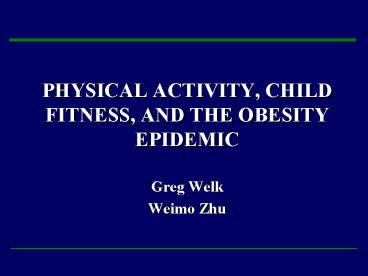PHYSICAL ACTIVITY, CHILD FITNESS, AND THE OBESITY EPIDEMIC - PowerPoint PPT Presentation
1 / 25
Title:
PHYSICAL ACTIVITY, CHILD FITNESS, AND THE OBESITY EPIDEMIC
Description:
... MODEL OF HEALTH RELATED FITNESS. Physical activity and physical fitness are often ... Relationships Between Physical Activity, Physical Fitness, and Health ... – PowerPoint PPT presentation
Number of Views:708
Avg rating:3.0/5.0
Title: PHYSICAL ACTIVITY, CHILD FITNESS, AND THE OBESITY EPIDEMIC
1
- PHYSICAL ACTIVITY, CHILD FITNESS, AND THE OBESITY
EPIDEMIC - Greg Welk
- Weimo Zhu
2
15.1 MODEL OF HEALTH RELATED FITNESS
- Physical activity and physical fitness are often
considered to be synonymous terms but they are
fundamentally differences and unique implications
for health.
3
Bouchard Shepard,1997
4
- Definitions and Descriptions of Physical Activity
and Inactivity - Physical activity (PA) is typically defined as
any bodily movement produced by skeletal muscles
that results in energy expenditure(11). - The term exercise is often used interchangeably
with the term physical activity but exercise
refers to a more structured (and planned) form of
physical activity that is done with a specific
purpose in mind
5
- Longitudinal studies have demonstrated that
activity levels decline by about 20-25 during
the period from 12-18 (Kemper, Post, Twisk, van
Mechelen, 1999) (Kimm et al., 2000) . - In any case, there is no denying the importance
of regular physical activity for youth.
6
- Descriptions and Definitions of Physical Fitness
- Physical fitnesss current model
- morphological fitness
- cardiorespiratory fitness
- metabolic fitness
- motor fitness and
- neuromuscular fitness
- (Bouchard Shepard, 1994).
7
- Cardiorespiratory fitness
- Cardiorespiratory fitness includes
- Categories of aerobic power,
- Heart functions (blood pressure)
- Lung function.
8
- Participation in physical activity that
challenges the cardiovascular system (aka aerobic
activity) helps to improve cardiorespiratory
fitness but the associations between habitual
physical activity and aerobic fitness are lower
in youth than in adults (Morrow Freedson,
1994).
9
- Morphological fitness
- Morphological fitness refers to indicators that
represent the structure and composition of the
body such as subcutaneous and visceral adipose
tissue, body fat distribution, and bone mineral
density.
10
- The primary component of interest is typically
body fatness
11
- Low levels of physical activity and high levels
of inactivity are causally associated with
changes in overweight in children - (Berkey et al., 2000 Gordon-Larsen, Adair,
Popkin, 2002)
12
- Metabolic fitness
- Metabolic fitness includes biochemical indicators
that are associated with a reduced risk of
cardiovascular disease and type II diabetes. - These indicators are known to be influenced by
physical activity and to relate directly to
health. Many of the Indicators of metabolic
fitness cluster together as part of an overall
metabolic syndrome that predisposes individuals
to cardiovascular disease (Lakka, Laaksonen, and
Lakka, 2002).
13
- Motor fitness
- Motor fitness, in this model, refers to
components that can improve the ability to learn
and perform complex skills required in some
sports and physical activities.
14
- Muscular fitness
- Muscular fitness includes the related
dimensions of power, strength and endurance. - Muscle endurance and muscle strength are
typically considered to be dimensions of health
related fitness because there are direct links to
health.
15
- Power (the combination of speed and strength), on
the other hand, is often considered to be a
dimension of skill related fitness (Corbin, Welk,
Corbin, Welk, 2007) - Speed is more genetically linked and less
responsive to training.
16
- A LIFESPAN MODEL OF PHYSICAL ACTIVITY AND HEALTH
Blair (1989)
17
- An important message in the model is that
physical activity and health-related risk factors
can both track from childhood into adulthood. - The relationships between physical activity and
health outcomes are reciprocal (bi-directional
arrows).
18
- Relationships Between Physical Activity, Physical
Fitness, and Health - Physical activity has effects on a variety of
physiological systems and has been shown to
impact each of the different components of HRF. - Activity and inactivity are both important in
obesity prevention in youth.
19
15.3THE YOUTH PHYSICAL ACTIVITY PROMOTION MODEL
- Youth Physical Activity Promotion (YPAP)
Model is a social-ecological model that was
developed to facilitate the targeting of
variables known to influence childrens physical
activity behavior (Welk, 1999).
20
- (Welk,1999)???????????
21
- Factors Influencing Physical Activity in Youth
Description of the YPAP Model - Predisposing Factors
- Predisposing factors refers to factors that may
predispose a child to be physically active.
22
- Enabling Factors
- Enabling factors refers to factors that enable a
child to be physically active. These can include
environmental variables such as access to
facilities, equipment, and programs that provide
opportunities for physical activity.
23
- Reinforcing Factors
- Reinforcing factors refers to support that a
child receives from significant others to be
physically active. Parents, peers and
teachers/coaches can all act to directly
influence childrens interest and involvement in
physical activity by providing opportunities for
children to be active through the day.
24
- Strategies for Promoting Physical Activity -
Application of the YPAP Model - School Based Physical Activity Promotion
- Family and Community Based Programming
25
THANKS































